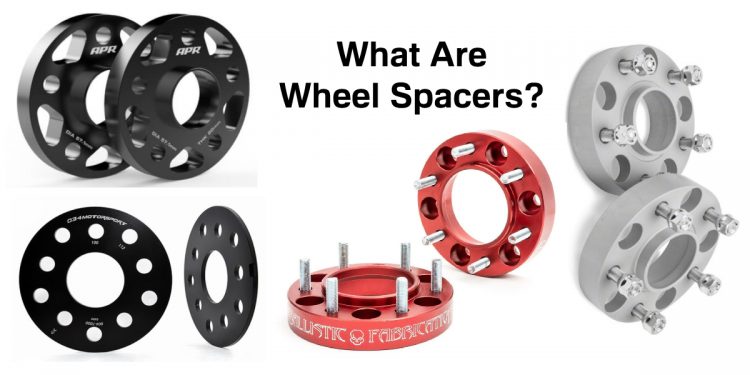Wheel spacers have one purpose and one purpose only: to move wheels further away from a vehicle’s body. As suggested by their name, wheel spacers offer more space in the area between the wheel hub assembly and the wheel itself. In order to create this additional room, the spacers are placed over the holding bracket.
This aftermarket part is fairly common and an inexpensive upgrade that boasts a number of benefits for both street-focused cars and off-roaders. In this article, we will go over the ins and outs of wheel spacers and what they can do for your car.
What Do Wheel Spacers Do?
Wheel spacers are round metal spacers that fit between your vehicle’s hub and the wheel. They install right on your wheel assembly. Spacers push the wheel further away from the body for a number of different reasons, including appearance, fitment, performance, and handling. It is important to note that spacers only move the wheel outward and not the hub assembly. The result is a larger gap between the wheel and wheel well.
There are plenty of benefits when it comes to adding wheel spacers, making them a fairly popular aftermarket part. They don’t, however, come pre-attached to any vehicle. Purchasing wheel spacers specifically for your type of vehicle ensures that it matches the bolt pattern and fits perfectly so you don’t experience any mounting issues.
Wheel spacers can run from 5mm (0.20 inches) all the way to 45mm (1.75 inches) or even larger. The bigger wheel spacer sizes are more common for off-road vehicles.
Why You Might Use Wheel Spacers?
In short, it’s not a good thing for your wheels to be in very close proximity to the inner components of the wheel well. This may cause some less than desirable driving characteristics and the tire could rub against the wheel liner and suspension parts during turns. The solution for this poor fitment is wheel spacers. Wheel spacers simply add a bit more room so you can avoid clearance issues that could lead to performance degradation.
Wheel spacers are commonly used on cars that have larger or wider tires. This is oftentimes due to a custom installation where the tires installed are bigger than the standard tires that came with the vehicle from the factory. In order to help them fit into the wheel well space, you may need wheel spacers to accommodate the new size.
Spacers can also give your vehicle a more aggressive appearance as the wheels will be pushed further out from the mainframe. They can appear flush with the fender or even stick out a bit, depending on the look and fitment you are going for. If this sounds like something you are interested in, wheel spacers can definitely help you get the offset you want.
The Pros of Wheel Spacers
Below, we will cover the advantages of installing wheel spacers on your vehicle.
Improved Appearance: Wheel spacers can give your vehicle a more unique stance and distinct look. Mild spacers can make your wheels flush with the factory fender flares, which many find to be an attractive look. Aggressive spacers more dramatically alter the appearance of your car, making it stand apart from stock versions. It’s also a popular choice for enthusiasts who frequent car shows and want that overall “stanced out” look. No matter if you choose the former or the latter, wheel spacers can help you achieve whatever aesthetic you are going for.
Better Car Handling: Spacers are popular among performance-oriented enthusiasts, because they can improve overall handling, grip, and cornering. The result of pushing the wheel away from the chassis is a wider track and lower center of gravity. By widening the distance between the driver’s side and passenger’s side wheels, your vehicle will be more planted. You will, consequently, experience more grip in corners, allowing for more control and faster acceleration response as you come out of it. To take advantage of these benefits, you should install spacers on all four wheels. If, for instance, you only install spacers in the front, you will get more grip in the rear and cause understeer and possible fishtailing (which can be considered a “con”).
Larger Wheels, Tires, Calipers: When it comes to road-focused vehicles, wheel spacers allow for wider tires for additional traction and improved handling. Off-roaders tend to choose bigger tires that are taller than the factory ones. If they don’t use spacers, these tires might rub against the wheel wells or fender flares, which is not a good thing at all. The aftermarket has wheel spacer sets with a larger pair for the rear or a separate pair for the rear altogether. This is because many drivers prefer adding larger wheels, not only on all four sides but sometimes in the rear alone. The icing on the cake? Spacers offer more room for larger calipers that wouldn’t otherwise fit in the factory wheel space. This proves especially beneficial for those looking into performance brake kits, which are often wider than the OE ones.
Inexpensive Mods: A good set of four wheel spacers can cost you around $100; of course there are cheaper and more expensive ones. Considering the positive impact they have on performance and style, this is a good bang for your buck. After all, there are not that many aftermarket parts that can boast these same benefits for the price point.
Easy Installation: The installation process for wheel spacers is fairly simple and straightforward. The difficulty level is about the same as putting a new set of wheels on. You can complete the install right in the comfort of your own garage or driveway using just basic tools. Each individual wheel can be finished in approximately 15 minutes, making this good project to take on no matter the day of the week.
The Cons of Wheel Spacers
Below, we will go over some disadvantages that can arise as a result of spacers.
Additional Wear and Tear: If your car has wheel spacers installed, the nearby suspension and hub components may experience accelerated wear. This is due to the added stress spacers place on parts that were originally designed to specifically tested tolerances set forth by the manufacturer. Because the wheels are pushed further out from the hub, additional stress is put on wheel bearings, hubs, and/or axles, which can cause these components to prematurely fail. The wider geometry caused by spacers can cause parts like the wheel bearings to wear out more quickly than normal, which most wouldn’t find ideal.
Heavier Steering: Depending on the size of your wheel spaces, you may experience heavier steering. The wider track means that more effort is required to turn the wheels, making it more difficult to turn the steering wheel. To reiterate, this is all dependent upon the width of the spacers you are using. For instance, the effects of a 1/4-inch spacer will differ from the effects of a 1- or 2-inch wheel spacer. What’s more, modern power steering makes this “con” easy to overlook.
Altered Suspension Traits: In addition to noticeably heavier steering, you may experience changes in your car’s suspension characteristics. For example, the springs and shocks on your vehicle will likely not absorb bumps and harsh road conditions as well as the stock setup.
Decreased Ride Quality: As aforementioned, your car was tested with a specific setup straight from the factory. In other words, the engineers who designed your vehicle have optimized it to a T, and installing wheel spacers may throw things out of balance. Having your wheels stick further out from their suspension components can result in worse ride quality. The bigger the spacers, the bigger the negative impact on overall ride comfort will be.
Are Wheel Spacers Safe?
If properly installed and on the proper application, high-quality wheel spacers are perfectly safe. The most common cause for failures is not due to the actual wheel spacers but installation issues. This includes incorrect hub bore (i.e. wheel to spacer or spacer to hub) and incorrect torque specs on the wheel bolts or lug nuts. If the wheel, hub, and spacer are all correct for the application and the bolts/lugs are torqued to the proper values, you should not have a problem running spacers. That does not, however, mean that your wheels and tires might not rub, but that is an entirely different situation.
That being said, it’s important to check your local laws to see if the regulations deem your setup legal or illegal. Having wheels that are not covered by a car’s fenders or wheel wells are not legal in a number of places. This is because there are certain codes in place to prevent the likelihood of rocks and other debris hitting other drivers or passersby.
Conclusion
To conclude, the advantages and disadvantages of wheel spacers ultimately come down to your overall vision, knowledge, and handling capabilities. While there are certainly potential dangers to consider with this aftermarket mod, most of the problems that occur are a result of inexperienced owners trying to adjust their wheel package in ways that go well beyond what the factory specs can support. If you are careful, do your research, and stay well within your car’s max tolerance levels, wheel spacers can offer several aesthetic and performance benefits. If you are looking to fit a bigger wheel and tire package on your car and enjoy better handling and traction, you may want to start looking into wheel spacers.
Some of our popular wheel spacer brands:




